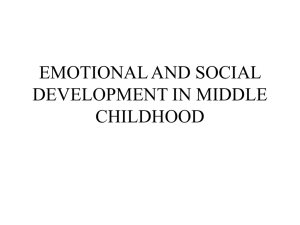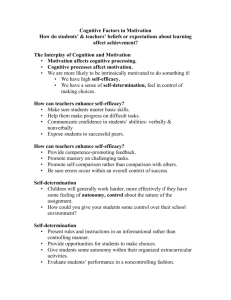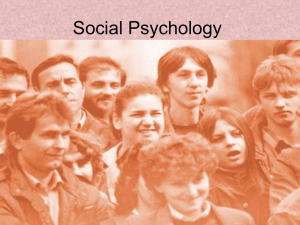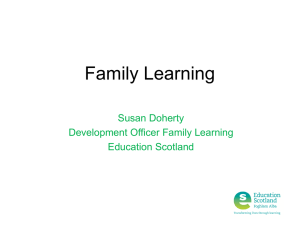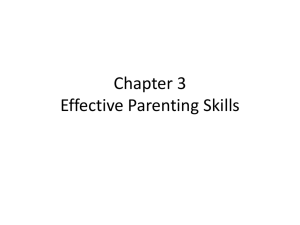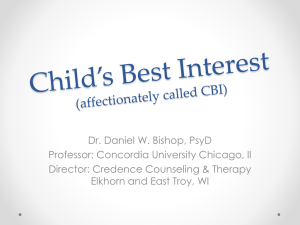Self-Concept - Gordon State College
advertisement
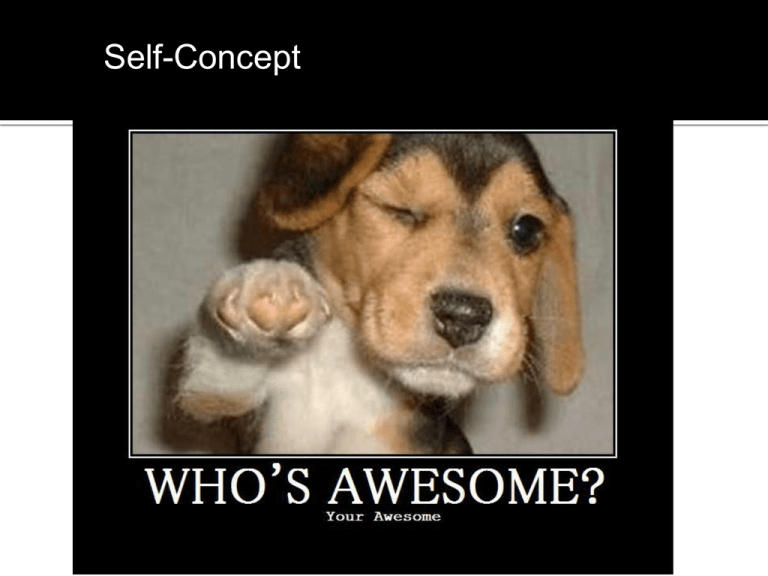
Self-Concept Definition – overall thoughts & feelings about ourselves. Fixed? Importance? “How you perceive yourself greatly affects the way you perceive your world…& behave in it.” What is a self-fulfilling prophecy? “Who am I, really?” – Carl Rogers Existential Angst – Victor Frankl An onion – Tony Campolo Thoughts & Actions Reflected Appraisal – evaluation (assumption) of how others see us. Significant others (George Herbert Mead) are valued for their opinion. Carl Rogers view of the phenomenal self ▪ ▪ Definition: Your perceived reality. It is your ever changing world of experiences, both internal and external. Self concept becomes filter for all experiences “I love you not only for what you are, but for what I am when I am with you. I love you not only for what you have made of yourself, but for what you are making of me. I love you for the part of me that you bring out.” - Elizabeth Barrett Browning Mad About You “I can tell you like it when I imitate you.” “I love it when you laugh when I hold this finger like this and curse! You look so proud!” Individuals have the following selfperceptions: An actual self (qualities people think they actually possess). An ideal self (qualities people would like to have). An ought self (qualities people think they should possess). More on the role of Parents – parenting styles. Two dimensions of parenting are important 1. Parental acceptance. 2. Parental control. Together, these dimensions yield four parenting styles (see Figure 6.11). The authoritative style is associated with the highest self-esteem scores. Figure 6.11. Baumrind’s four parenting styles. Four parenting styles result from the interactions of parental acceptance and parental control, as theorized by Diana Baumrind. Adapted from Baumrind, D. (1971). Current patterns of parental authority [Monograph]. Developmental Psychology, 4(1, Part 2), 1-103. American Psychological Association. Adapted by permission of the author. Other sources: Teachers, classmates, and close friends Those who feel competent, relative to others, have the highest self-esteem. Festinger’s (1954) social comparison theory states that we compare ourselves with others in order to assess and/or improve our abilities. A reference group. If we want to improve, we choose reference groups of superior quality, but If we want to bolster self-esteem, we choose inferior groups. Cognitive processes affect the ability to maintain a view of the self. Two different types of processes are at work: 1. Automatic processing – default mode 2. Controlled processing – active thinking required for important decision-making and analysis. MAKING THE AUTOMATIC CONTROLLED – MINDFULNESS Awareness of Mental Distortions Self-attributions – are “inferences that people draw about the causes of their own behavior”. Three key dimensions of attributions: 1. Whether they are internal or external. – Internal attributions – “ascribe the causes of behavior to personal dispositions, traits, abilities, and feelings”. – External attributions – “ascribe behavior to situational demands”. Dimensions of attributions, continued 2. Whether they are stable or unstable. – Stable attributions – the cause of behavior is unlikely to change over time. – Unstable attributions – the cause of behavior is variable, or subject to change. Dimensions of attributions, continued 3. Whether they are controllable or uncontrollable. – This dimension simply considers whether or not the individual has any control over the behavior. Explanatory style – refers to the “tendency to use similar causal attributions for a wide variety of events in one’s life”. People who use an optimistic explanatory style attribute setbacks to external, unstable, and specific factors. People who use a pessimistic explanatory style attribute setbacks to internal, stable, and global factors (see Figure 6.13). Figure 6.13. The effects of attributional style on expectations, emotions, and behavior. The pessimistic explanatory style is seen in the top row of boxes. This attributional style, which attributes setbacks to internal, stable and global causes, tends to result in an expectation of lack of control over future events, depressed feelings, and passive behavior. A more adaptive, optimistic attributional style is shown in the bottom row of boxes. Self-efficacy – “one’s belief about one’s ability “ can be learned and changed. increasing self-efficacy is beneficial to one’s physical and mental health. Mastery experiences – Learning new skills increases self-efficacy. 2. Vicarious experiences 3. Persuasion and encouragement 4. Interpretation of emotional arousal – When we try new things, we may become nervous. – It is important to attribute this to normal arousal needed to do well, rather than fear. 1. LOOKING AT AUTOMATIC THOUGHTS Four motives guide self-understanding. 1. Self-assessment – desire for truthful information about oneself. 2. Self-verification – preference for feedback that matches our self-view. 3. Self-improvement – looking to successful others in order to improve ourselves. 4. Self-enhancement – desire to maintain positive feelings about oneself. Methods of self-enhancement 1. Downward social comparison – a “defensive tendency to compare oneself with someone whose troubles are more serious than one’s own”. 2. Self-serving bias – “tendency to attribute one’s successes to personal factors and one’s failures to situational factors”. Methods of self-enhancement, continued 3. Basking in reflected glory – “tendency to enhance one’s image by publicly announcing one’s association with those who are successful”. 4. Self-handicapping – “tendency to sabotage one’s performance to provide an excuse for possible failure”. 3 Primary needs in significant relationships Genuineness Empathy Acceptance: Unconditional positive regard These promote Self Actualization Relationships Conscious Choice Behaviorist (Skinner) & Humanist (Rogers & Maslow) believe we consciously decide what information to incorporate. Answering the BIG questions ▪ Who am I, really? – Carl Rogers ▪ Why am I here? Existential Angst – Victor Frankl ▪ Who’s the real me? An onion – Tony Campolo Are you 2,3,4…faced? If so, when? If so, is that a bad thing? Selves: Actual self Ideal self Ought selves Possible selves Self-Discrepancy – different views are inconsistent Cognitive Dissonance Discrepancy between actual & ideal = depression (hopeless) Discrepancy between actual & ought = anxiety (guilt) 1. Commitment & Crises Identity Diffusion No commitment or crises 2. Identity Foreclosure No crises, inherited commitment 3. Identity Moratorium Crises without commitment 4. Identity Achievement Relationships Conscious Choice Unconscious Sources Freud & Jung believed self concept was unconscious Jung believed in innate personality traits. The Myers-Briggs test is based on Jung’s trait descriptions and help you understand your innate tendencies. Self-consistency – perceiving experiences in a manner consistent with self-concept. Cognitive Conservatism – we tend to manage new information so that it accords with what we already know or think we know. • Discounting positive or negative contradictions. ▪ ▪ ▪ ▪ Even when a situation positively contradicts our selfconcept we tend to minimize or deny its implications. Self-concept = I’m bad at math Result = Did good on test Response = Teacher made a mistake or dumb luck. Self-serving bias (attributions) Internalize positive Externalize negative • Beneffectance (Greenwald) – our tendency to take credit for what proves good but not the responsibility for what proves bad. • Egocentrism – we tend to overestimate our influence in a situation or the extent to which we are the target of attention. • Self-enhancement Theory – try to get positive feedback about our qualities. Self-verification Theory – we want to be known and understood by others according to our firmly held beliefs and feelings about ourselves. ▪ We act and communicate in ways to shape other’s evaluation of us. Comparison to similar others ▪ may distort and deny the similarities. ▪ Deny similarities with people who have problems due to similar behavior (AIDS). Comparison to less adequate to feel better Rationalization - Creating false but plausible excuses to justify unacceptable behavior. Identification - Bolstering self-esteem by forming an imaginary or real alliance with some person or group. Displacement - Diverting emotional feelings (usually anger) from their original source to a substitute target. Regression - A reversion to immature patterns of behavior. Repression - Keeping distressing thoughts and feelings buried in the unconscious. Projection - Attributing one’s own thoughts, feelings, or motives to another. 1. 2. 3. 4. 5. Identify causes of low self-esteem Identify domains of competency Demonstrate achievement Actively cope with challenge Promote social support & approval Mr. Clean & Mr. Dirty Study (Gergen, 1970) Dress for success Self-esteem can change with comparisons Self-esteem can very smaller amounts depending on strength High esteem parenting Low esteem parenting very accepting express affection set firm but reasonable rules. either overly strict, overly permissive, or inconsistent. Dweck (1999) praise children for their efforts rather than intelligence increases children’s desire for more challenges. 1. Preencounter Eurocentrism 2. Encounter I’ll never fit 3. Immersion/Emersion Ethnic Pride Guilt 4. Internalization/Commitment Incorporation without reactionism http://www.self-esteemnase.org/research.shtml#crime http://www.jrf.org.uk/pressroom/releases/281 101.asp
